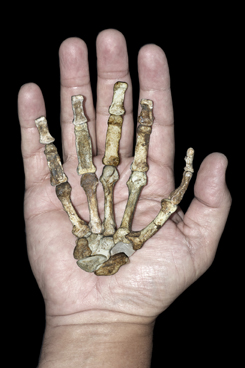By Ashley Yeager
Note: This is the first in a four-part, monthly series that will give readers recipes that they can try in their kitchen and also learn a little chemistry and physics along the way.

Making sucre à la crème (left) and soft toffee (right) illustrates the fundamental principles of changing a liquid to a solid. Credit: Ashley Yeager, Duke.
A dozen freshmen pull on pieces of fresh, soft toffee, popping the candy into their mouths and licking it from their teeth as chef Justine de Valicourt talks about making the treats in a tiny kitchen on the second floor of Smith Warehouse.
Eating toffee and other sweets doesn’t usually spark a discussion about chemistry. But, as the students learn, the core of the eating experience is entirely about chemistry and some physics too, says professor Patrick Charbonneau.
He is leading a freshman seminar, called the Chemistry and Physics of Cooking, and in this particular class, he, de Valicourt and a team of teaching assistants work with the students to explore phase transitions – such as the change of liquid water to ice – by making two traditional Québécois desserts, sucre à la crème and soft toffee.
Both desserts have the same ingredients — maple syrup, butter and cooking cream. But, the experience of eating them is entirely different. One, the toffee, is stretchy, chewy and sticky, while the other, the sucre à la crème, is more crumbly and smooth.
The way the sugar molecules in solution cool down into a solid structure is what determines the final texture of a candy or chocolate, Charbonneau says.
During the lab, the students cool one mixture of syrup, butter and cream quickly and then whisk it. The stirring motion forces the sugar molecules to bump into each other, creating seeds of crystallization, which continue to grow and eventually clump together to give the sucre à la crème its solid, crumbly texture.
The students mix and heat the ingredients, then let them cool slowly, leaving the candy to set for at least three hours. Not whisked or stirred, it solidifies without forming too many large crystals, giving it a glassier appearance and a stickier, chewy texture, a signature feature of toffee.
Making these candies is pretty basic, easy enough that anyone could try it in a home kitchen, Charbonneau says, adding that he and de Valicourt have provided the recipes as a way to reach beyond the classroom and give more than just their students an introduction to cooking and, of course, the chemistry behind it too.
Sucre à la crème —
Ingredients:
1 can of maple syrup (540mL)
45 g (3 tbsp.) of butter (plus some to grease the mold)
250 ml (1 cup) of cooking cream 35%
Materials:
1 medium saucepan
1 candy thermometer
1 wooden spoon
1 square mold
1 whisk
1 bucket of cold water
Instructions:
1. Put all ingredients in the saucepan. Stir.
2. Heat on the stove to 118°C (244°F) – 120°C (248°F). Be careful not to touch the bottom of the pan with the thermometer, which will give an incorrect reading.
3. Put the saucepan in the bucket of cold water and let the mixture cool down to 55°C (131°F) – 60°C (140°F) in the center. Do not stir the mixture.
4. Once cooled in the water, whisk the mixture to make a creamy pale paste. Pour in the mold and cut it before it gets too hard.
5. Let it rest 30 min in the fridge.
Soft toffee —
Ingredients:
1 can of maple syrup (540mL)
45 g (3 tbsp.) of butter (plus some to grease the mold)
250 ml of cooking cream 35%
Materials:
1 medium saucepan
1 candy thermometer
1 wooden spoon
1 square mold
Instructions:
1. Put all ingredients in the saucepan. Stir.
2. Heat on the stove to 118°C (244°F) – 120°C (248°F). Be careful not to touch the bottom of the pan with the thermometer, which will give an incorrect reading.
3. Pour into the greased mold, let it cool down slowly, without disturbing it for 3-8 hours.














